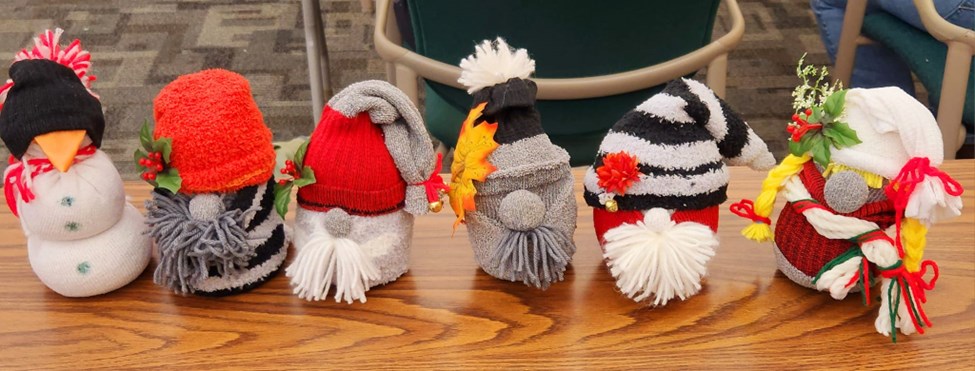
Crafts Around the World Series Europe: Norwegian Gnome - Nisse
DOWNLOADOctober 11, 2023 - Janis Brinn, Michigan State University Extension
Purpose
Introduce youth to some simple cultural traditional crafts from around the world. Journey around the continents, learning how to make simple crafts and having fun creating.
Objectives:
- Learn the cultural history and origins of the craft.
- Inspire global exploration.
- Develop fine motor skills in working with fabric.
- Increase cultural awareness and creativity.
Education Standards:
- Understand the visual arts in relation to history and culture.
- Apply geometric methods to solve design problems.
Experiential Learning:
Create designs by cutting, assembling, and gluing.
Encourage thought and discussion with these questions: What happened? What’s important? So what? Now what?
Audience:
Grades K-12
CONTINENT: EUROPE
Home to 44 countries, Europe is the sixth largest of the world’s continents. Some areas of the world combine Asia and Europe into one continent called Eurasia.
COUNTRY:NORWAY
Norway is a country of northern Europe that occupies the western half of the Scandinavian peninsula. Scandinavia is a region of Europe, made up of Norway, Sweden, and Denmark. Scholars often include other nations such as Iceland and Finland. The first 4-H club in Norway was founded in 1926, just 12 years after Michigan 4-H, which officially started in 1914 (Brinn et al., 2019). 4H Norge’s (Norway 4-H) motto is “learning by doing” (4H Norge, n.d.).
LESSON: Norwegian Nisse
In Norway, a gnome is called a nisse — a creature who lives in barns or homes, protecting the countryside and the people who live there. A common part of Norwegian folklore and legend, the nisse has a long white beard with a conical or knit cap, often in red or another bright color. The small gnomes from folklore have inspired modern Scandinavian holiday traditions. In one legend, a nisse felt insulted until he was given a Christmas porridge called julegrot. The legend led to a tradition of leaving julegrot with butter out on Christmas Eve to appease the gnomes and bring good luck, wealth, and protection to the farm and family (Ingebretsens, 2017).

TIME:
30-45 minutes or multiple days depending upon the interest to learn more.
MATERIALS:
- 3 socks (1 gray or of any skin color, and 2 colorful)
- 3 cups rice, uncooked (or substitute pillow stuffing or beans)
- 2 rubber bands
- Scissors
- Pompoms (optional)
- Buttons (optional)
- Yarn (approximately 22 feet)
- Hot glue and glue gun (or fabric craft glue)
PROCEDURE: How to make Norwegian gnomes
- Fill the gray or skin-colored sock with 3 cups of dry, uncooked rice. Pillow stuffing and beans can be substituted for rice.
- Tie the open end of the sock securely with a rubber band, creating a tight seal.
- Trim and remove the excess sock.
- To create a nose for the gnome, pinch the sock 1/3 of the way up from the base into the size and shape desired.
- Secure the nose with a rubber band.
- Place the sock filled with rice into a colorful sock. Fold the open end of the colorful sock inside itself, creating a neat top edge, securely under the nose.
- To create a hat for the gnome, place a sock with a colorful pattern on the head of your gnome. Decorate the hat with pompoms, buttons, or other decorations (optional).
- To create a beard for the gnome, set aside 8 inches of yarn and wrap the rest in loops approximately 9 inches wide.
- Tie the loops together in the middle using the 8-inch string of yarn.
10. Cut the loops of yarn on both ends.
11. Hot glue the yarn beard in place or use fabric craft glue. (Adults should handle the glue gun.)
12. Give your gnome a name and place it in its new home!
INSTRUCTIONAL VIDEO LINK:
View this instructional video from Kentucky 4-H to guide you in creating your gnome:
Art and Science – Experiment with various types of fabric or materials. Try various sewing techniques and designs. Ask questions and make discoveries!
Folklore – Research about Scandinavian folklore and other customs, traditions, and folk tales. Think about your own culture: What are common creatures in your own folk stories, legends, and fairytales?
Reflection Questions: What surprised you and why? When were you the most creative, and why do you think that is? What made you curious today? What can you do with what you learned today?
REFERENCES:
Brinn, J., Sommers, B., Egner-Kaupang, S., & Hapasaalo, P. (2019, December 26). 4-H around the world: Kansainvälinen 4H. Michigan State University Extension. https://www.canr.msu.edu/news/4_h_around_the_world_norway
4H Norge. (n.d.) 4H: To learn by doing! About 4H - 4h
Ingebretsens. (2017, January 31). Legend of the nisse and tomte.
https://ingebretsens-blog.com/legend-of-the-nisse-and-tomte/
ACKNOWLEDGMENTS:
The activity was developed by Michigan State University Extension Educator Janis Brinn in 2023. Instructions are adapted with permission from Sandra van de Looij – Kleinendorst in Scandinavian Christmas Gnomes From Socks (www.instructables.com/Scandinavian-Christmas-Gnomes-From-Socks/). Instructions and additional information are adapted with permission from the Kentucky 4-H International Program in Scandinavian Culture: Woven Heart Ornaments and Gnomes (4LE-04LO). University of Kentucky.(www2.ca.uky.edu/agcomm/pubs/4LE/4LE04LO/4LE04LO.pdf)



 Print
Print Email
Email





